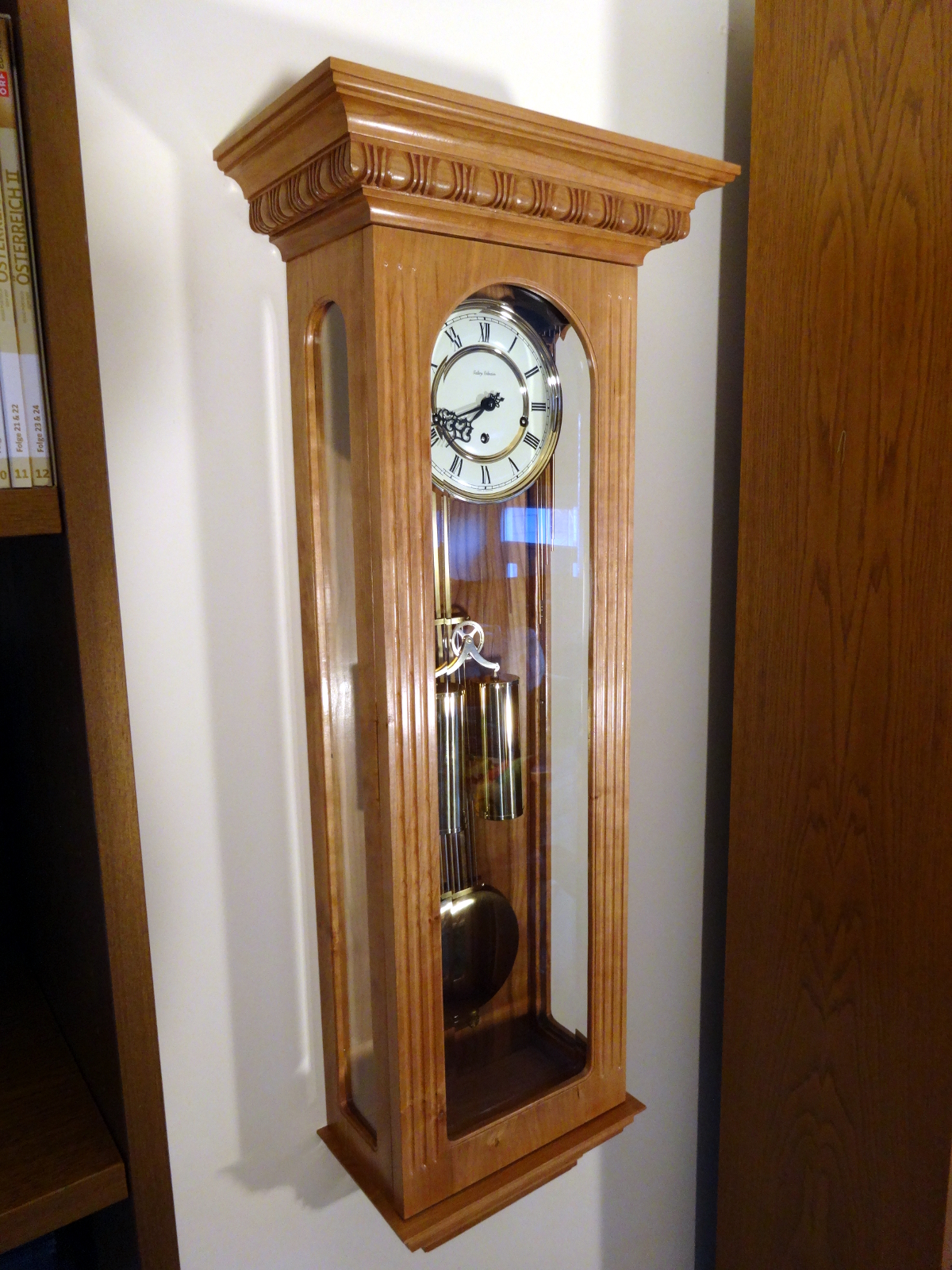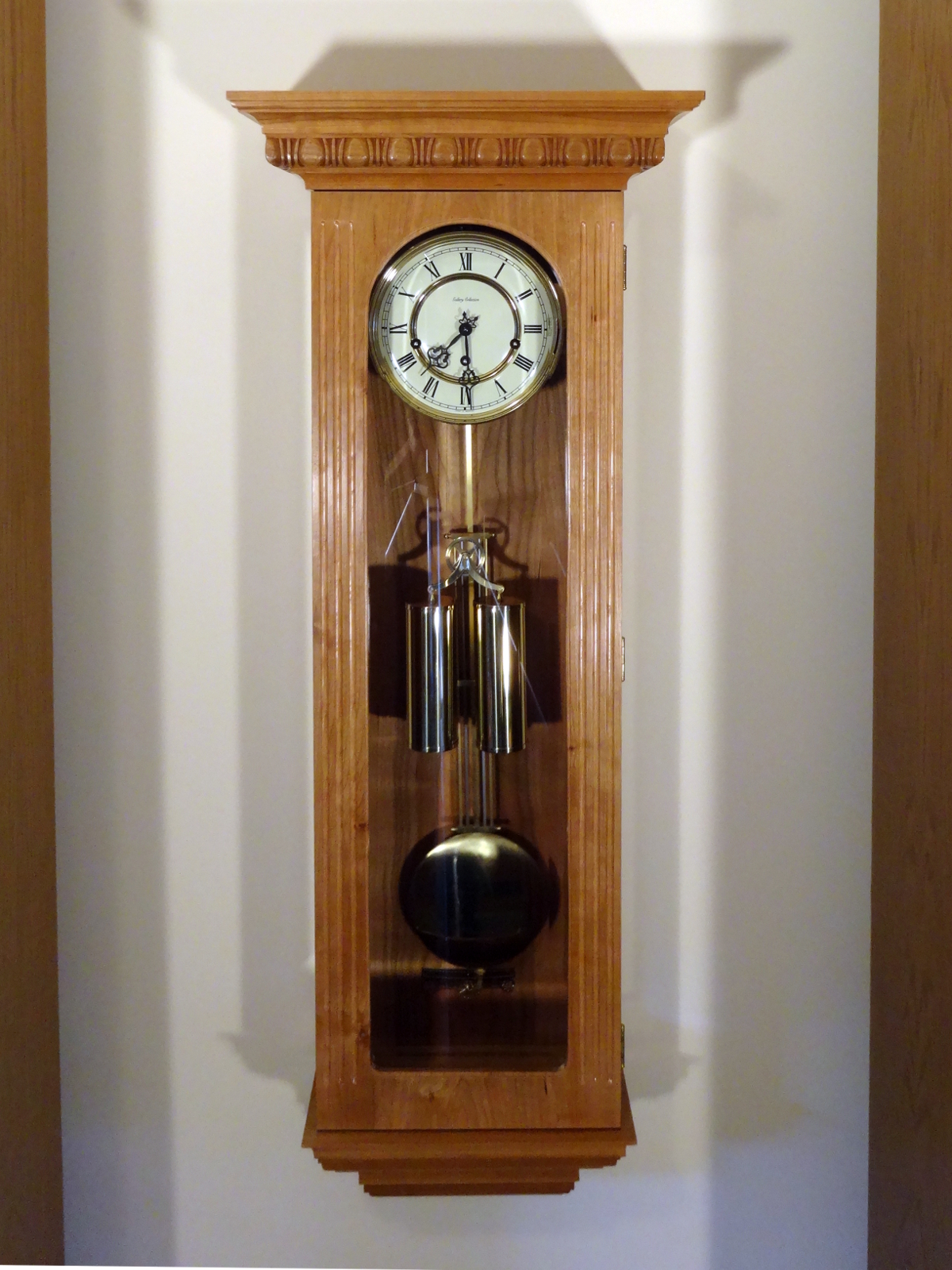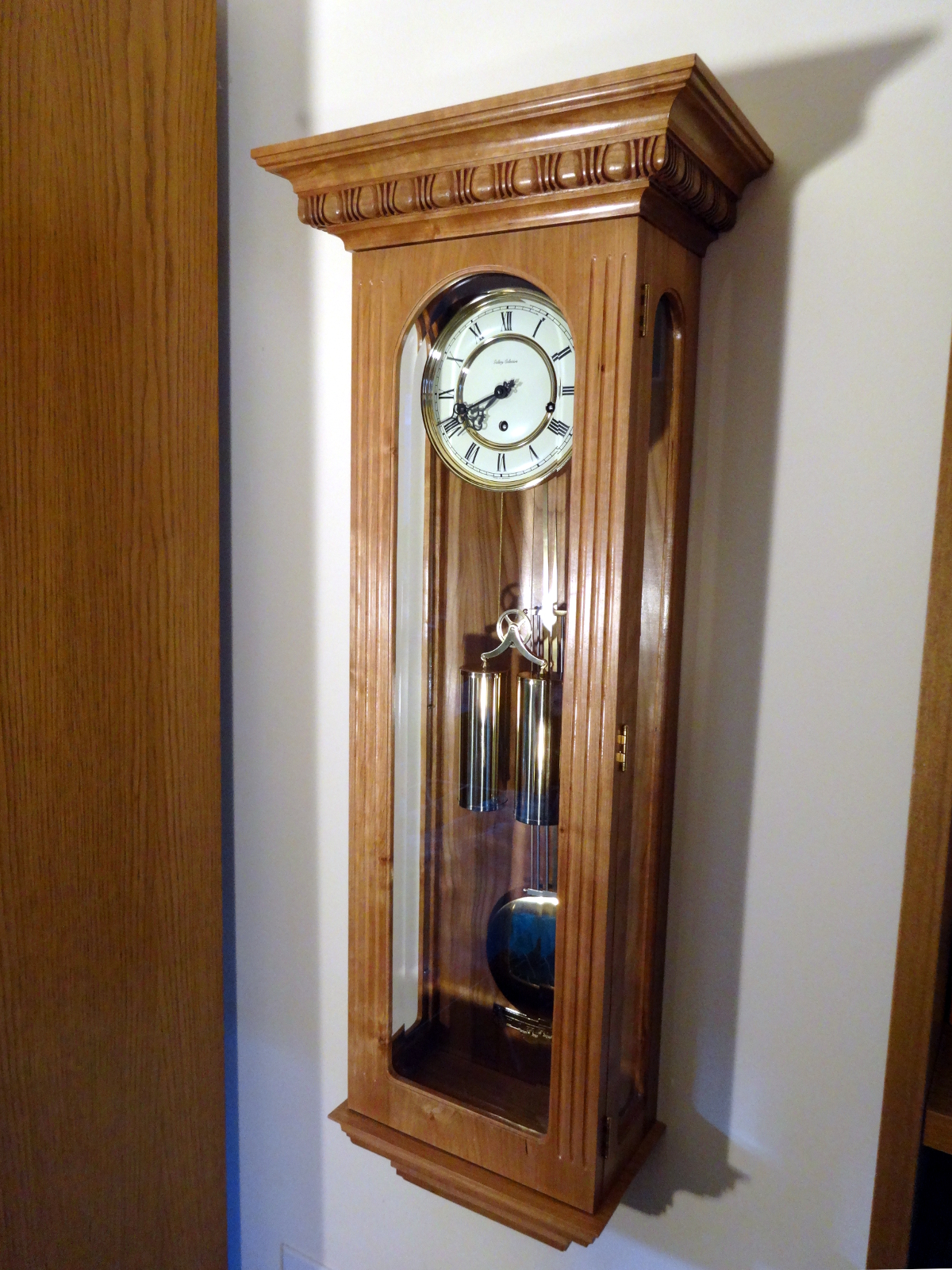Ding Dong the Clock is Done!
Movement: Hermle Westminster Chime – 351-830 – 8 day – 66 cm pendulum
Overall height: 41 inches
Case height: 34 inches
Case width: 11 1/4 inches
Case depth: 6 1/2 inches
Crown width: 16 inches
Crown depth: 8 3/4 inches
Weight: 38 pounds
Wood: American Cerry
Finish: Shellac and furniture wax
Making this clock has been a long journey. I purchased the plans, movement and lumber years ago. A variety of moulding planes and other tools accumulated over time, until I decided last fall to tackle this “bucket list” project. I have very much enjoyed every minute of the project, even the adventure of acquiring the glass. The result now hangs on the wall between a couple of large bookcases.
The last steps before final assembly were installing the glass. I used framing points to hold the glass in place, and supplemented those with a thin bead of clear silicone caulk to ensure the glass stays where I want it within the openings, and to dampen any tendency to rattle.
Wall mounting uses two screws. The top screw is one intended for plasterboard application and rated for 80 pounds. A single “hang hole” in the back board hangs the clock on that screw. A lower screw protrudes from the wall only far enough to fit into a snug slot on the back of the back board. This screw keeps the clock firmly positioned vertically. Mechanical clock movements are sensitive to the vertical axis for keeping the pendulum swinging smoothly.
Total weight is 38 pounds. Those two brass cylinders contain lead weights. Combined they weigh 12 pounds and provide very constant motive power for the time keeping part of the clock. Two chime movements, one for the Westminster quarter-hour melodies, and the other for the hour strikes, are powered by springs.
On being a “Regulator”
We all know mechanical movements are no longer the most accurate time keepers. Electronic crystal regulators surpassed mechanics long ago.
BTW, very few mechanical clocks or watches and the vast majority of electronic crystal regulated timepieces are still not accurate enough to be considered chronometers. Chronometer accuracy is critical to determining longitude at sea and is better than -4 to +6 seconds per day.
Accuracy is a relative thing. In the era where mechanical clocks were the only clocks, the Regulator was one of the more accurate. Every jeweler and clock maker kept at least one regulator which they used as the reference for setting all other clocks and watches they touched. The key to the regulator’s accuracy is the use of a weight driven timekeeping movement. Springs, the normal motive power for mechanical clocks, offer too much variance in behavior: strong when wound tight, weaker as they unwind. Gravity is far more uniform. The gravitational force on the weights provide a uniformity that springs can’t match. That uniformity gives the clock much of its accuracy.
Even with that uniformity of motion, this clock is not as accurate as a chronometer, no where close to being one. Yet this clock is currently running to +/- a dozen seconds per day. Regulation is by a small nut that lengthens or shortens the pendulum.
Gratitude: hearing the chimes of a mechanical clock – video
Other articles in this series…
- Regulator Clock – Done
- Regulator Clock – Woodworking completed
- Regulator Clock – Scratching the frames
- Regulator Clock – Door Hinged
- Regulator Clock – Case Dry Fitted
- Regulator Clock – Jelly Side Down
- Regulator Clock – Case Frames – 2
- Regulator Clock – Glass – 2
- Regulator Clock – Case Frames – 1
- Regulator Clock – The Works work
- Regulator Clock – Glass
- Regulator Clock – Tongue & Groove planes
- Regulator Clock – Completed Mouldings
- Regulator Clock – Stick Mouldings
- Regulator Clock – Plate Mouldings
- Regulator Clock – Egg and Dart Moulding
- Regulator Clock – Eat Dessert First
- Regulator Clock – original description
- Regulator Clock – Stock Prep
- Regulator Clock – Plans for Moldings
- Taming the Rabbet




Congratulations, Bob. I enjoyed following along with your build. It’s really beautiful. Cross this one off your list.
Thanks Matt.
Looks great, Bob.
Thanks Derek.
Very nice! Digital and atomic just don’t have the same style.
I know it was a long journey, but the end result looks to be well worth the effort.
Thanks Greg.
Nice job Bob
Thanks Andy.
Never you had a blog Bob, I think it’s wonderful. The clock is also beautiful a job well done. I read your article on PayPal and am quite shocked about the fines. I never about it before and thankfully I’ve never had an issue with them. But it is concerning though. Not sure what they can fine anyone for though.
Thanks for stopping by Salko.
I stopped by to have a look at your clock a little more in depth. For one it’s truly handmade which is what gives it character and a higher value than factory mass machined clocks you see in every jewellers store. Despite what you have written about the mechanicals not being as accurate as the digital, nothing sure beats the tick-tock and chime as you presented in the video of a mechanical. I think you and Matt by far have the best blogs I’ve yet seen to date.
Btw I skimmed through my comment above and I have this tendency to think faster than I write, which results in words being skipped. Just ask Matt what caused his bald spot. Lol
Thanks Salko,
We really enjoy the clock. It currently hangs on an interior wall of a well built stone walled home. The climate stays a steady temperature year around with humidity about 65%. I gave the clock its 5-year lube job a few months ago and re-regulated it. It is currently running +/- 2 seconds / week. That accuracy comes from being gravity driven, not spring driven, and from very careful pendulum adjustment.
Don’t worry about missing words. I’ve always understood everything you’ve written. Keep havin’ fun and making beautiful things.
This may sound like a silly question, but is there a way that I can subscribe to you? I keep having to check in and search for posts that hold my comments for reply. Is there a way to get notified when you post a reply or even a new post for that matter?
Hey this is a beautiful clock! I’m curious about how you mounted the movement in the case (hardware etc). It looks like you used some standoffs or something similar? I just got the same 351-830 with a 66cm pendulum and am trying to figure out how to mount it before I build a case. It’s my first time building a clock so I don’t totally know what I’m doing. I’m looking at similar styles to yours so I love your blog. Again, wonderful job!
You are very observant Spenser. Yes, there are standoffs. The problem is that I don’t remember buying them separately. I bought the plans and movement from Klockit when they used to feature this particular clock and sell that movement. Perhaps they included the standoffs? Looking at then just now, they appear to be well matched the movement … and absolutely necessary to provide clearance for the pendulum.
I certainly don’t remember buying the standoffs separately. Now, where to get some? The best I can suggest is to revisit the place where you found the movement and see what they have.
Maybe http://www.cmi-hermle.com, areksmurrayclock.com, http://www.clockworks.com, or http://www.merritts.com?
Your on your way to a beautiful clock. Enjoy!
P.S. Carefully consider how you will mount it to the wall. My mounting uses two bolts/screws, one to carry the weight and the other for positioning. The main drawback is that it is clumsy to use when taking the clock down for periodic maintenance and getting it back on the wall. It’s a heavy clock, and fiddling with getting it hung up quickly isn’t so quick.
Expect to oil the movement every 3-4 years.